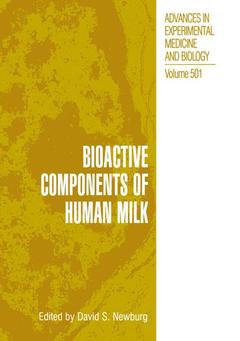Description
Bioactive Components of Human Milk, Softcover reprint of the original 1st ed. 2001
Advances in Experimental Medicine and Biology Series, Vol. 501
Coordinator: Newburg David S.
Language: English
Subjects for Bioactive Components of Human Milk:
Keywords
Lipid; apoptosis; cytokine; development; efficiency; growth; immune system; infection; metabolism; nutrition; protein; proteins
Bioactive Components of Human Milk
Publication date: 10-2012
592 p. · 17.8x25.4 cm · Paperback
Publication date: 10-2012
592 p. · 17.8x25.4 cm · Paperback
Approximative price 349.99 €
Subject to availability at the publisher.
Add to cart
Bioactive components of human milk (POD)
Publication date: 12-2001
Support: Print on demand
Publication date: 12-2001
Support: Print on demand
Contents
/li>
Dedication. Preface; D.S. Newburg. Section I: Introduction. 1. Bioactive components of human milk: evolution, efficiency, and protection; D.S. Newburg. 2. Human milk and the response of intestinal epithelium to infection; K. Bernt, W.A. Walker. 3. MUC1 and MUC-X, epithelial mucins of breast and milk; S. Patton, M.-G. Awardee. 4. Drug transport into milk; P.J. McNamara. Section II: Hormones & Growth Factors in Mammary Development and in Milk. Overview. 5. The transforming growth factors beta in development and functional differentiation of the mouse mammary gland; C.W. Daniel, et al. 6. Is milk a conduit for developmental signals? K.D. Nusser, L.S. Frawley. 7. Regulation of cell apoptosis by insulin-like growth factor 1; D.L. Hadsel, G. Abdel-Fattah. 8. Human milk contains detectable levels of immunoreactive leptin; R.E. Lyle, et al. 9. Induction of expression of branched-chain aminotransferase and alpha-keto acid dehydrogenase in rat tissues during lactation; S. DeSantiago, et al. 10. A low-fat diet but not food restriction improves lactational performance in obese rats; K.M. Rasmussen, et al. 11. Human lactoferrin in the milk of transgenic mice increases intestinal growth in ten-day-old suckling neonates; P. Zhang, et al. 12. Growth rates of a human colon adenocardinoma cell line are regulated by the milk protein alpha-lactalbumin; L.G. Sternhagen, J.C. Allen. Section III: Molk Lipids and the Milk Fat Globule. Overview. 13. Assembly and secretion of the lipid globules of milk; T.W. Keenan. 14. Prolonged breast-feeding (six months or more) and milk fat content at six months are associated with higher developmental scores at one year of age within a breast-fed population; C. Agostoni, et al. 15. Presence of carotenoid, an anticarcinogenic marker, in nipple aspirates postlactation; C. Covington, et al. 16. The anticarcinogenic conjugated fatty acid c9, t11-C18:2, or rumenic acid, in human milk: amounts and effects; R.G. Jensen, C. Lammi-Keefe. 17. Long-chain polyunsaturated fatty acid concentrations in human hindmilk are constant throughout twelve-month lactation; C. Agostoni, et al. 18. Parenteral infusion of a lactating woman with intralipid: changes in milk and plasma fatty acids; R.G. Jensen, et al. 19. Investigation of long-chain polyunsaturated fatty acid metabolism in lactating women with stable isotope techniques; H. Demmelmair, et al. 20. Structural and functional aspects of three major glycoproteins of the human milk fat globule membrane; J.A. Peterson, et al. 21. Anti-infectious properties of the human milk fat globule membrane; H. Schroten, et al. Section IV: Immunomodulatory and Anti-Inflammatory Agents in Milk. Overview. 22. Homeostasis of mucosal immune system: human milk and lactation; J. Mestecky. 23. Anti-inflammatory characteristics of human milk: how, where, why; E.S. Buescher. 24. Development of a topical vaginal microbicide: lessons learned from human milk; C.E. Isaacs, et al. 25. Does human lactoferrin in the milk of transgenic mice deliver iron to suckling neonates? L.H. Hanson, et al. 26. Changes in lactoferrin and lysozyme levels in human milk during the
© 2024 LAVOISIER S.A.S.

